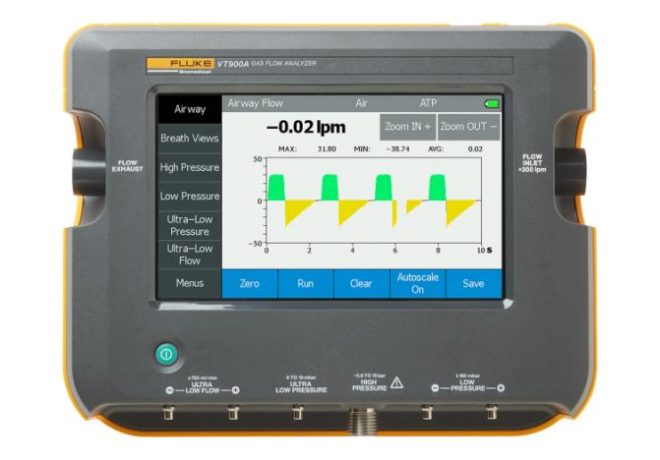


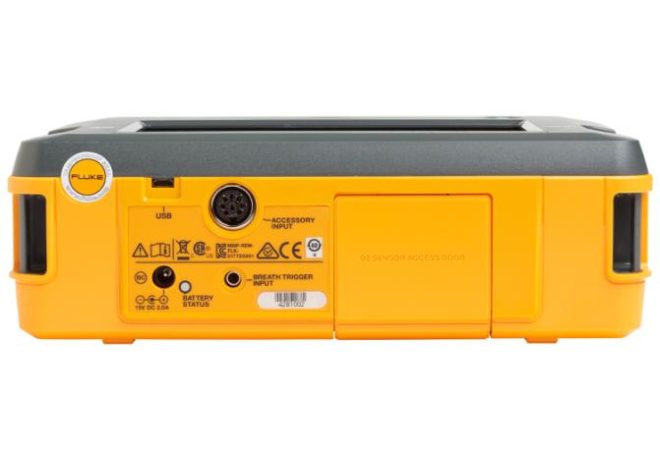
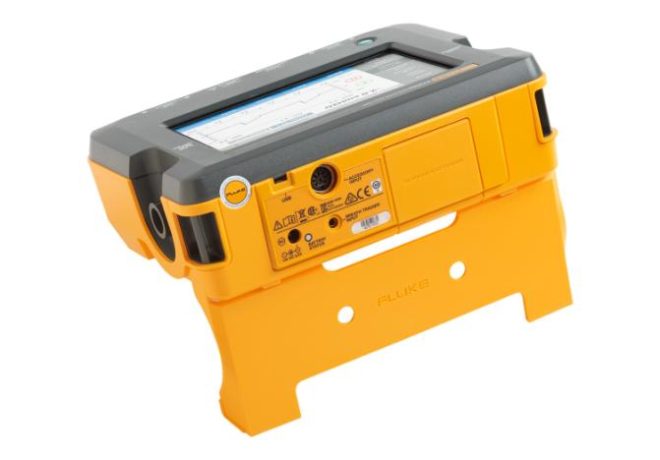
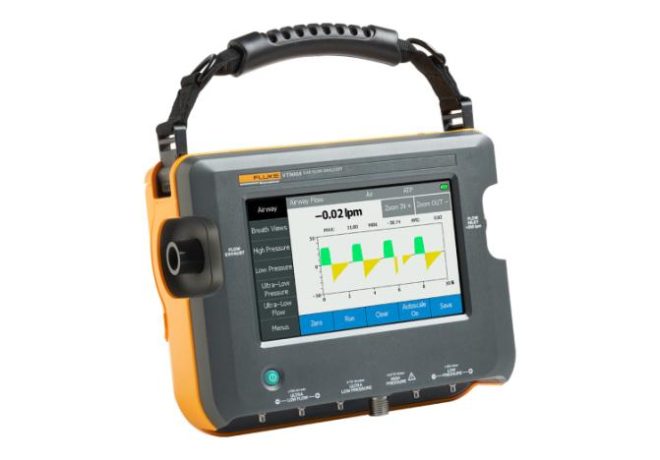
VT900A Gas Flow Analyzer Ventilator Tester
VT900A Gas Flow Analyzer Ventilator Tester

Accurate
The VT900A is LifeForce Biomedical’s high-accuracy premium gas flow analyzer and ventilator tester. The single, full-range ±300 lpm air flow channel offers built-in oxygen, temperature and humidity measurements to streamline testing and automatically compensate for environmental conditions. The VT900A features an external trigger input and special ultra-low flow and ultra-low pressure ports.
Easy To Use
The VT900A offers a large 7’’ (17.8 cm) touch screen display, allowing you to view multiple measurements at once, and quickly access menu options. Review results in graphical or numerical data in real-time. The global user interface makes operating this device straightforward and uncomplicated.

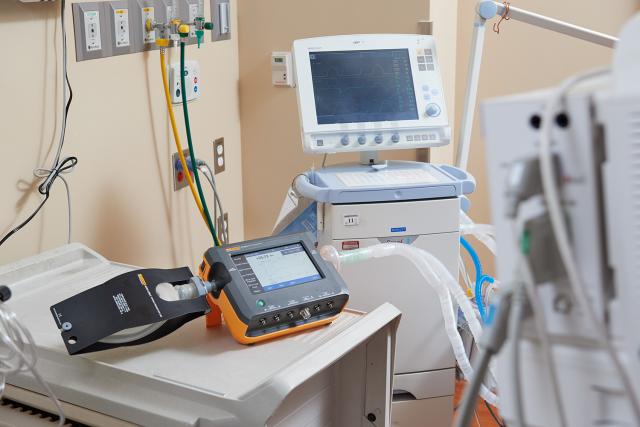
Traceable
The large on-board memory of the VT900A Gas Flow Analyzer / Ventilator Tester allows both short and long-term recording and storing of test data. Transfer data via USB to a PC and upload the generated test file to your CMMS system for simple reporting. This device can be easily adapted to specific testing needs. With the ability to create custom profiles and the capacity to take remote commands for automated testing, the VT900A Gas Flow Analyzer / Ventilator Tester helps to decrease risk and increase efficiency.
Portable

Key Features
- Streamline your testing procedure, reduce errors and quicken your test time with the ability to create customized test profiles
- Avoid confusion and ensure accuracy with one-channel, full range air flow
- Reduce testing time with built-in line sensors which automatically test humidity, temperature and oxygen while compensating for atmospheric pressure and environmental conditions
- Ensure patient safety with ultra-low flow and ultra-low pressure anesthesia and flow meter testing
- Have confidence that your measurements comply to global regulatory standards and adhere to SI units of measurement with the Molbloc-L calibration system.
- Easily transport and store the lightweight (3.6lb/1.6kg), all-in-one device – no extra modules for different tests
- Have more control over your medical equipment testing by selecting your own trigger point with the external trigger input
- Operate on-the-go, all day with 8 hours of battery life
- Streamline your testing procedure by performing a complete anesthesia machine PM with the VAPOR Anesthesia Tester
The features that differentiate the VT900A and VT650 are the ability to measure ultra-low flow and ultra-low pressure, the ability to use an external TTL trigger input and improved oxygen sensor accuracy and lifetime (1% accuracy and a 2-year lifetime vs. 2% accuracy and a 1-year lifetime).
From a technical standpoint, there is no difference between the VT900 and the VT900A. The only difference is that a connector was added at the rear panel to allow for power and communication to the VAPOR Anesthesia Tester
The VAPOR Anesthesia Tester is an accessory to the VT900A that allows for preventive maintenance / efficacy testing of vaporizers. VAPOR can test the concentration of 5 major anesthetic agents, CO2 and N2O.
VT900 lacks the connector on the rear panel that provides power and communication to the VAPOR Anesthesia Tester. Only the VT900A has this connector.
All of these products have an 8-hour battery life allowing you to test all day, on-the-go.
Saving results is easy on any of these units. From any screen there is a blue box in the bottom right called “Save”. Press on this button and you are able to save your results as data, a graph, a recording or under a new Test ID. These results can then be recalled from the onboard memory under “Menus” and “Memory”.
There are two sensors to zero on these devices. The first is the airway flow sensor. You want to zero this without the breathing circuit attached. From the “Airway” screen, press “Zero”.
The second sensor to calibrate is the oxygen sensor. From the “Menus” screen, press “Calibrate Oxygen” and the device will lead you through the steps to calibrate your sensor using air and oxygen.
The connection to our gas flow analyzers changes depending on the testing you are about to do.
If you are testing breath parameters or bi-directional flow the connection should be a Y connector on the flow inlet side and a calibrated test lung on the flow exhaust side. Always use an antibacterial filter on the inlet side to elongate the life and accuracy of your gas flow analyzer.
When testing uni-directional flow or concentration measurements the DUT simply needs to be connected to the flow inlet side using an antibacterial filter.
The connection of VT900A for testing the ventilator function of an anesthesia delivery system is unchanged from normal breath by breath or constant flow testing.
VAPOR needs to be used to test the anesthetic agent concentrations as well as carrier gas concentrations. VAPOR is connected to the VT900A using the connector on the back of the VT900A. The inlet should be connected to the fresh gas outlet using a tee connector to pull a side stream sample. The exhaust ends of the tee connector and VAPOR should be connected to the anesthesia gas scavenging system (AGSS).
WARNINGS:
- Do not run anesthetic agent through any ports of the VT900A.
- Only pull side stream samples into VAPOR using a tee accessory.
The breath detection mode should be changed depending on what it is that you are testing. Breath detection modes can be changed under “Menus”, “Setup”, “Breath Detect”.
If you are testing breath parameters using a test lung, you want to be in bi-directional mode. This will allow the flows to pass through the gas flow analyzer in both directions to simulate human breathing.
Uni-directional flow or continuous “off” flow is used when testing parameters that should be at a constant setting (flow rates, oxygen concentration). This allows for the gases to pass through the gas flow analyzer in only one direction.
The connection to our gas flow analyzers changes depending on the testing you are about to do.
If you are testing breath parameters or bi-directional flow the connection should be a Y connector on the flow inlet side and a calibrated test lung on the flow exhaust side. Always use an antibacterial filter on the inlet side to elongate the life and accuracy of your gas flow analyzer.
When testing uni-directional flow or concentration measurements the DUT simply needs to be connected to the flow inlet side using an antibacterial filter.
Under “Menus” and “Special Tests” there are a number of tests that can help troubleshoot and identify failure modes. These tests include:
- Airway Pressure Leak Test
- High Pressure Leak Test
- Low Pressure Leak Test
- Ultra-Low Pressure Leak Test
- Trend Test
- Stacked Volume Test
- High Frequency Test
There are certain applications that require high resolution and high accuracy to ensure functional performance. Examples of such devices would be anesthesia machines and neonatal ventilators. In these applications, you simply connect the tubing to the ports on the nearside of the VT900A and switch your screen to the ultra-low flow and ultra-low pressure views.
The Excel Plug-In is used to download test data to your PC for upload. The Excel Plug-In can download numerical data as well as graphs to ensure that you are able to get your test results into a report and even into your CMMS. Easily download the Plug-In from the gas flow analyzer software page and install on your PC.
